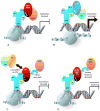Corepressors of agonist-bound nuclear receptors
- PMID: 17628626
- PMCID: PMC2148130
- DOI: 10.1016/j.taap.2007.05.019
Corepressors of agonist-bound nuclear receptors
Abstract
Nuclear receptors (NRs) rely on coregulator proteins to modulate transcription of target genes. NR coregulators can be broadly subdivided into coactivators which potentiate transcription and corepressors which silence gene expression. The prevailing view of coregulator action holds that in the absence of agonist the receptor interacts with a corepressor via the corepressor nuclear receptor (CoRNR, "corner") box motifs within the corepressor. Upon agonist binding, a conformational change in the receptor causes the shedding of corepressor and the binding of a coactivator which interacts with the receptor via NR boxes within the coregulator. This view was challenged with the discovery of RIP140 which acts as a NR corepressor in the presence of agonist and utilizes NR boxes. Since then a number of other corepressors of agonist-bound NRs have been discovered. Among them are LCoR, PRAME, REA, MTA1, NSD1, and COPR1 Although they exhibit a great diversity of structure, mechanism of repression and pathophysiological function, these corepressors frequently have one or more NR boxes and often recruit histone deacetylases to exert their repressive effects. This review highlights these more recently discovered corepressors and addresses their potential functions in transcription regulation, disease pharmacologic responses and xenobiotic metabolism.
Figures

Similar articles
-
Corepressor recruitment by agonist-bound nuclear receptors.Vitam Horm. 2004;68:123-43. doi: 10.1016/S0083-6729(04)68004-6. Vitam Horm. 2004. PMID: 15193453 Review.
-
Nuclear receptor repression: regulatory mechanisms and physiological implications.Prog Mol Biol Transl Sci. 2009;87:235-59. doi: 10.1016/S1877-1173(09)87007-5. Epub 2009 Oct 7. Prog Mol Biol Transl Sci. 2009. PMID: 20374706 Review.
-
The CoRNR motif controls the recruitment of corepressors by nuclear hormone receptors.Nature. 1999 Nov 4;402(6757):93-6. doi: 10.1038/47069. Nature. 1999. PMID: 10573424
-
Equilibrium interactions of corepressors and coactivators with agonist and antagonist complexes of glucocorticoid receptors.Mol Endocrinol. 2004 Jun;18(6):1376-95. doi: 10.1210/me.2003-0421. Epub 2004 Mar 11. Mol Endocrinol. 2004. PMID: 15016838
-
Molecular dynamics simulations for human CAR inverse agonists.J Chem Inf Model. 2012 Feb 27;52(2):457-64. doi: 10.1021/ci200432k. Epub 2012 Jan 25. J Chem Inf Model. 2012. PMID: 22233089
Cited by
-
ASXL1 represses retinoic acid receptor-mediated transcription through associating with HP1 and LSD1.J Biol Chem. 2010 Jan 1;285(1):18-29. doi: 10.1074/jbc.M109.065862. Epub 2009 Oct 31. J Biol Chem. 2010. Retraction in: J Biol Chem. 2015 Mar 6;290(10):6008. doi: 10.1074/jbc.A109.065862. PMID: 19880879 Free PMC article. Retracted.
-
RaRF confers RA resistance by sequestering RAR to the nucleolus and regulating MCL1 in leukemia cells.Oncogene. 2018 Jan 18;37(3):352-362. doi: 10.1038/onc.2017.329. Epub 2017 Sep 25. Oncogene. 2018. PMID: 28945224
-
Selective ligand activity at Nur/retinoid X receptor complexes revealed by dimer-specific bioluminescence resonance energy transfer-based sensors.FASEB J. 2015 Oct;29(10):4256-67. doi: 10.1096/fj.14-259804. Epub 2015 Jul 6. FASEB J. 2015. PMID: 26148973 Free PMC article.
-
Peroxisome Proliferator-Activated Receptor-γ Is Critical to Cardiac Fibrosis.PPAR Res. 2016;2016:2198645. doi: 10.1155/2016/2198645. Epub 2016 May 12. PPAR Res. 2016. PMID: 27293418 Free PMC article. Review.
-
Emerging roles for TNIP1 in regulating post-receptor signaling.Cytokine Growth Factor Rev. 2012 Jun;23(3):109-18. doi: 10.1016/j.cytogfr.2012.04.002. Epub 2012 Apr 28. Cytokine Growth Factor Rev. 2012. PMID: 22542476 Free PMC article. Review.
References
-
- Ashkar S, Mesentsev A, Zhang WX, Mastyugin V, Dunn MW, Laniado-Schwartzman M. Retinoic acid induces corneal epithelial CYP4B1 gene expression and stimulates the synthesis of inflammatory 12-hydroxyeicosanoids. J Ocul Pharmacol Ther. 2004;20:65–74. - PubMed
-
- Augereau P, Badia E, Balaguer P, Carascossa S, Castet A, Jalaguier S, Cavailles V. Negative regulation of hormone signaling by RIP140. J Steroid Biochem Mol Biol. 2006;102:51–59. - PubMed
-
- Barbier O, Villeneuve L, Bocher V, Fontaine C, Torra IP, Duhem C, Kosykh V, Fruchart JC, Guillemette C, Staels B. The UDP-glucuronosyltransferase 1A9 enzyme is a peroxisome proliferator-activated receptor alpha and gamma target gene. J Biol Chem. 2003;278:13975–13983. - PubMed
-
- Colombo A, Bonfanti P, Orsi F, Camatini M. Differential modulation of cytochrome P-450 1A and P-glycoprotein expression by aryl hydrocarbon receptor agonists and thyroid hormone in Xenopus laevis liver and intestine. Aquat Toxicol. 2003;63:173–186. - PubMed
Publication types
MeSH terms
Substances
Grants and funding
LinkOut - more resources
Full Text Sources
Other Literature Sources
Miscellaneous

